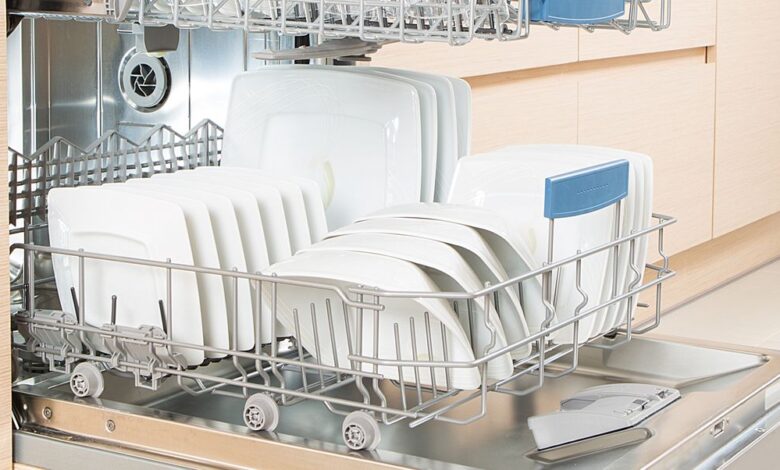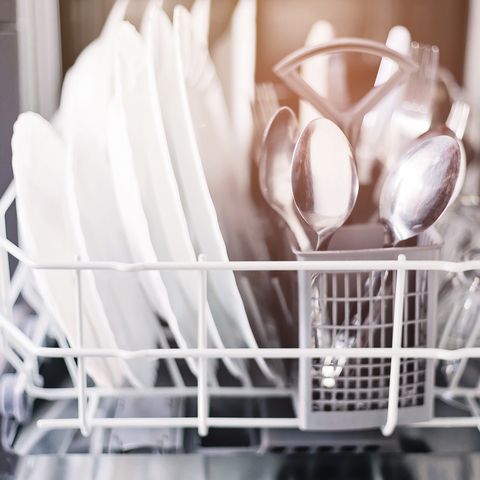The 5 Quickest, Easiest Ways to Help Your Dishwasher Clean Like It’s Brand New

Your dishwasher is constantly cleaning, so it must be one of the most pristine appliances in your home, right? Not quite.
With regular use, your machine—and its hidden parts—accumulates bits of food, grease, limescale (that chalky-looking film you see as a result of hard water), and undissolved detergent. These things can interfere with how well it cleans, says Lynn Redmile, Testing and Product Review Analyst in the Good Housekeeping Institute’s Cleaning Lab.
Thankfully, with a few simple strategies and the right products, taking care of your machine is easy. Here’s what the experts recommend.
Once per month, use dishwasher cleaner to remove grease build-up and mineral deposits.
As mentioned, build-up of any kind can result in your dishes not being cleaned properly or lead to food residue, which can make your dishwasher smelly and unhygienic.
To combat this, use a dishwasher cleaner, like Finish® Dishwasher Cleaner Liquid, approximately once per month, says Redmile. The process is low-effort—simply use as directed: Set an empty machine to the hottest cycle, remove the sticker on top of the bottle’s cap and turn it upside-down on the lowest rack, close the door, and start the dishwasher. As the cycle runs, the cleaning solution tackles all of that built up grease and limescale—even on hard-to-reach parts of the machine, like the filters, spray arms, and pipes.
Scrape or wipe items before loading.
Simply scrape off any remaining food from your dishes—there’s usually no need to pre-rinse if using a high-quality detergent, like Finish QUANTUM. This step dislodges any bits of food that were hanging on before items go into the dishwasher, where detergent takes care of the rest.
Face all items toward the center where the spray is strongest.
As a general rule of thumb, always position the dirty side of any dish down or to the center of the machine to ensure that water can reach and effectively clean it, says Redmile.
To load the machine properly, plates should go on the bottom rack with the dirty surfaces angled where the water spray is strongest, usually the center of the rack. Pots, pans, and casseroles should also go on the bottom rack, angled down for the best cleaning results. Glasses should go on the top rack and between the rack tines—not over them—to minimize water spotting and to prevent them from breaking. If your dishwasher has a flatware basket, place forks with the tines facing up, knives with the blade down, and spoons alternating, so they don’t nest into each other.
Avoid overlapping items or blocking the spray arms.
As tempting as it may be to cram dishes into the dishwasher that won’t fit, resist the urge. You should never stack items, because the water spray won’t be able to reach (or clean) the dish that’s on top, says Carolyn Forte, Director of Good Housekeeping Institute’s Home Appliances and Cleaning Products Lab. Remember: “If the water can’t reach it, it won’t get clean,” she explains.
Regularly clean the filter.
If your dishwasher’s filter isn’t clean, you’ll have trouble getting your dishes as clean as they could be, says Redmile. And luckily, it’s not too hard to do. The easiest way to keep it clean is with regular use of a dishwasher cleaner, like Finish. But in between deep cleanings make it a habit of pulling out the bottom rack to look for and remove any leftover food that may have fallen into the well below the lower spray arm.
It’s also a good idea—if your dishwasher has a removable filter—to give it a quick check from time to time. On most models, simply unlock and remove it (usually found below the bottom spray arm, though your owner’s manual can direct you further) and rinse it under hot running water, says Forte. Then, go over the mesh screen and plastic frame with a sponge or soft brush, like an old toothbrush, to remove any grease or particles stuck in the crevices. Then, just lock it back into place.
Before calling it quits, you should also wipe around the door’s edges and rubber gasket with a wet cloth or sponge to ensure no grease or food particles are left behind, says Redmile.
This content is created and maintained by a third party, and imported onto this page to help users provide their email addresses. You may be able to find more information about this and similar content at piano.io
Source link








